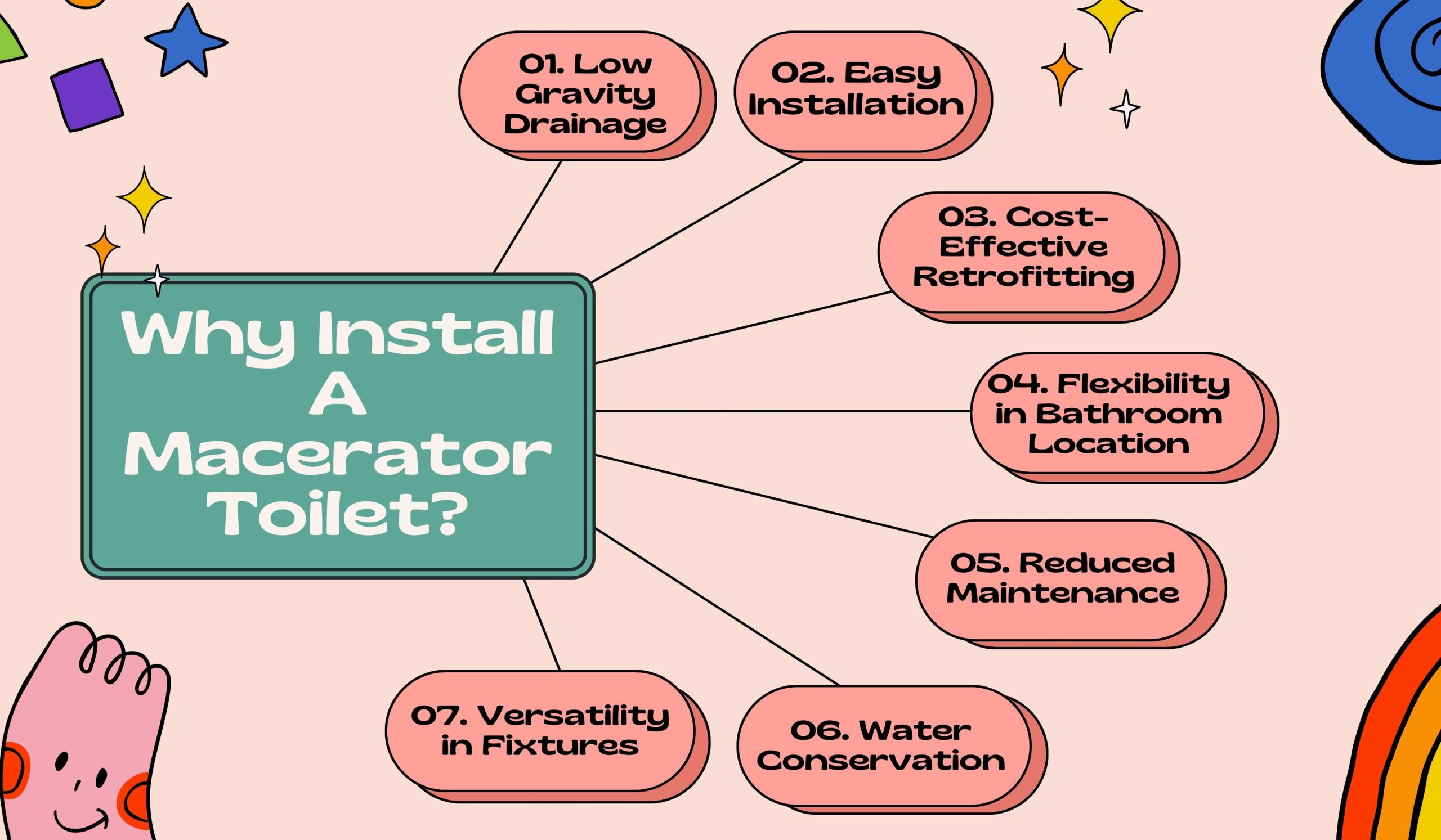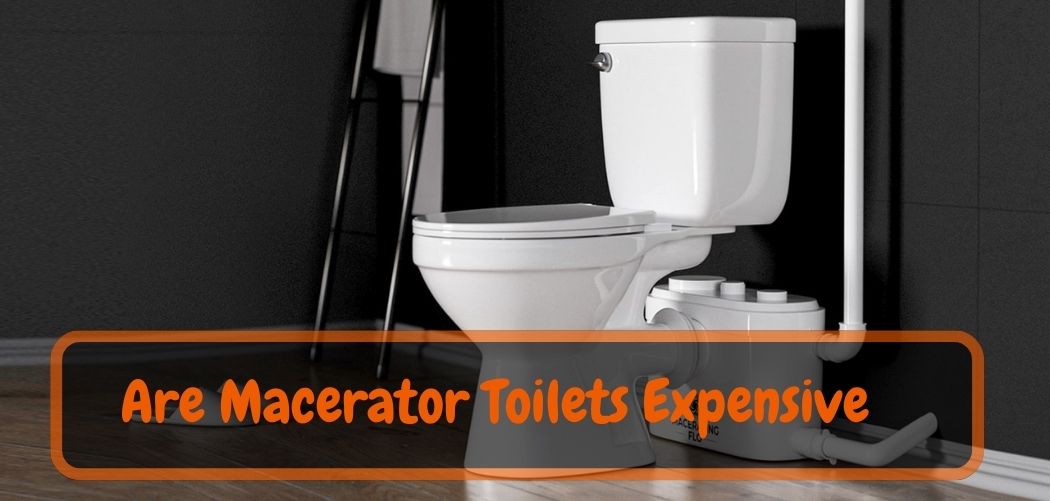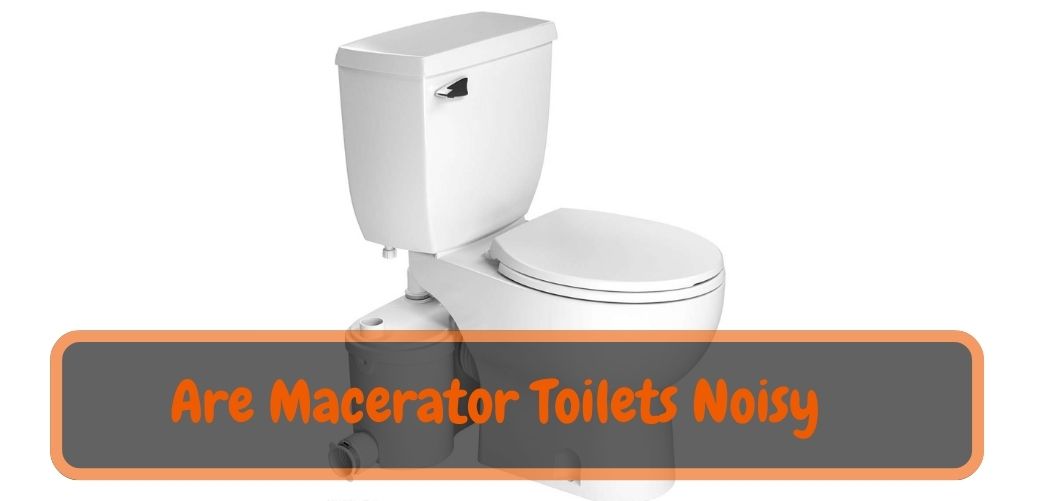Installing a macerator toilet can be beneficial in various situations where a traditional gravity-based toilet isn’t practical or feasible.
A macerator toilet, also known as a macerating toilet or upflush toilet, utilizes a macerating pump to grind waste and toilet paper into a fine slurry before pumping it through small-diameter pipes to the main sewer or septic system.
Here are some reasons why someone might choose to install a macerator toilet:
01. Low Gravity Drainage:
If you have a basement or a bathroom located below the main sewer line or septic system, a macerator toilet allows you to install a bathroom in such areas where gravity drainage isn’t possible or is cost-prohibitive.
02. Easy Installation:
Macerator toilets are relatively easy to install compared to traditional toilets in areas with challenging plumbing setups. They don’t require the extensive construction and alteration of existing plumbing systems.
03. Cost-Effective Retrofitting:
If you’re renovating or converting a space into a bathroom and the existing plumbing is difficult to modify, a macerator toilet can be a cost-effective option. It eliminates the need to break concrete or install new plumbing lines.
04. Flexibility in Bathroom Location:
Macerator toilets provide flexibility in locating a bathroom within a property, as they can be installed in various areas, such as basements, attics, garages, or even under staircases, where conventional plumbing may be difficult to implement.
05. Reduced Maintenance:
Macerator toilets are designed to grind waste and toilet paper, reducing the likelihood of clogs and blockages in the plumbing system. This can result in lower maintenance and fewer plumbing issues.
06. Water Conservation:
Macerator toilets use less water per flush than traditional toilets. This helps save water and may lower bills.
07. Versatility in Fixtures:
Macerator systems can handle not only toilets but also other fixtures like sinks, showers, and bathtubs, allowing you to create a complete bathroom wherever needed.
It's important to consult with a plumbing professional before installing a macerator toilet to ensure that it's a suitable option for your specific plumbing needs and to comply with local building codes and regulations.
Also Read: Unlocking the Truth: Macerator Toilets – Boon or Bane?
Difference Between a Macerator Toilet and a Regular Toilet!
Here’s a table highlighting the differences between a macerator toilet and a regular toilet:
| Feature | Macerator Toilet | Regular Toilet |
|---|---|---|
| Mechanism | Uses a macerator pump to grind waste into a slurry before flushing. | Uses gravity to move waste directly into the sewage or septic system. |
| Installation | Typically easier to install in locations where traditional plumbing is challenging. | Requires standard plumbing connections and often more straightforward to install. |
| Flexibility | Can be installed below the main sewer line, allowing for more versatile placement within a building. | Limited by the need for gravity flow and proximity to existing sewer lines. |
| Flush Type | Uses a special flushing mechanism to break down waste into a more manageable form. | Relies on a straightforward water flush to move waste through the pipes. |
| Space Requirements | Can save space due to its ability to be installed in unconventional locations. | Requires a certain amount of space for the traditional plumbing layout. |
| Maintenance | May require more maintenance due to the macerator pump and associated components. | Generally has simpler maintenance needs and may be more familiar to plumbers. |
| Noise Level | Tends to produce more noise during operation due to the macerator pump. | Typically quieter during operation as it relies on gravity for waste movement. |
| Cost | Can be more expensive due to the additional components and specialized design. | Generally more cost-effective in terms of initial purchase and installation. |
It's important to note that the choice between a macerator toilet and a regular toilet depends on various factors, including the specific plumbing requirements of the location, available space, budget, and maintenance preferences.
Also Read: Silent or Screechy: Are Macerator Toilets Noisy?
Why Should You Use a Macerator Toilet?
A macerator toilet is used when a regular toilet won’t work well or isn’t efficient. Here are the primary reasons why you might choose to use a macerator toilet:
1. No Gravity Drainage Available:
If a bathroom is below the main sewer line or septic system, a macerator toilet can dispose of waste without gravity drainage.
2. Basement or Below-Ground Bathrooms:
If you’re building a bathroom in a basement or an area with limited access to the main sewer line, you can use a macerator toilet. This toilet can dispose of waste without changing the plumbing system too much.
3. Minimal Disruption during Installation:
To install a regular toilet, you may need to change the structure of your home and do a lot of plumbing. A macerator toilet is easy to install and perfect for retrofitting or renovations.
4. Cost-Effective Plumbing Solutions:
Installing conventional plumbing systems, especially in existing buildings, can be expensive and labor-intensive. A macerator toilet is a cheaper option because it reduces the need for complex plumbing changes.
5. Versatility in Bathroom Location:
You can install macerator toilets in different places in a building, like basements, attics, or garages. This flexibility allows you to create bathrooms where traditional plumbing wouldn’t be practical.
6. Efficient Waste Disposal:
Macerator toilets use a grinder or macerating pump to break down waste and toilet paper into a fine slurry before pumping it through narrow pipes. This process minimizes the risk of clogs and ensures efficient waste disposal.
7. Water Conservation:
Macerator toilets typically use less water per flush compared to traditional toilets. This can help save water in homes and businesses by using less water overall.
8. Easy Addition of Fixtures:
Macerator systems can handle not only toilets but also other fixtures like sinks, showers, and bathtubs. You can make whole bathrooms or add more facilities without changing the plumbing much.
A macerator toilet is a practical solution for specific plumbing challenges, providing flexibility, cost-efficiency, and effective waste disposal in scenarios where traditional gravity-based toilets may not be suitable.
Also Read: Unlocking the Mystery: How Big is a Macerator Toilet ?
FAQs about Macerator Toilets:
1. What are the common problems associated with macerator toilets?
- Macerator toilet problems can include clogs, malfunctions in the macerating unit, pump failures, and issues with the electrical components. Regular maintenance and proper use can help mitigate these problems.
2. What are the pros and cons of using a macerating toilet?
- Pros: Easy installation, flexible location options, cost-effective for renovations, handles waste efficiently, water conservation due to lower flush volume.
- Cons: Potential for mechanical issues, noise during operation, maintenance needs, limited discharge distance, and reliance on electricity.
3. How does a macerator toilet work?
- A macerator toilet uses a grinding mechanism (macerator) to break down waste and toilet paper into a slurry. The slurry is then pumped through narrow pipes to the main sewage line or septic system.
4. What are the building regulations for installing a macerator toilet?
- Building regulations for macerator toilets vary by location. In general, they need to follow local plumbing and electrical codes. To ensure proper installation and compliance, consult with a professional.
5. What is the cost associated with installing a macerator toilet?
- Macerator toilet costs vary based on brand, features, and installation complexity. The total cost, including the unit and installation, can vary from a few hundred to a few thousand dollars.
6. Can a macerating toilet system handle a shower as well?
- Yes, a macerating toilet system can often handle a shower in addition to a toilet. Macerating systems can handle showers, sinks, bathtubs, and toilets. They allow for complete bathrooms in tricky plumbing situations.
Closing Reminder: choose a macerator toilet for versatile bathroom placement, cost-effective installation, efficient waste disposal, and water conservation. It's an ideal solution when gravity drainage is challenging or costly, providing flexibility and functionality for your plumbing needs.










